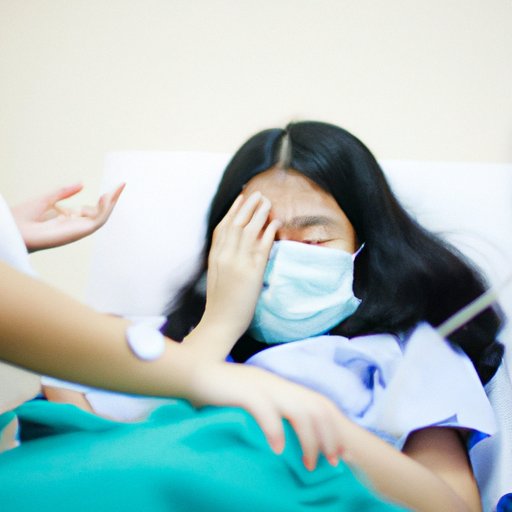I. Introduction
Communicable diseases, also known as infectious diseases, are caused by bacteria, viruses, or other pathogens that can be spread from person to person or through contact with contaminated objects or surfaces. Understanding communicable diseases and how they spread is crucial to preventing outbreaks and protecting public health. In this article, we will break down the basics of communicable diseases, discuss the different ways they can spread, provide advice for staying healthy, and highlight some common types of communicable diseases.

II. Breaking Down the Basics: Understanding Communicable Diseases
Communicable diseases are illnesses that can be transmitted from one person to another. This can happen through direct contact with bodily fluids or secretions, through the air when an infected person coughs or sneezes, or by touching a contaminated surface or object. Unlike non-communicable diseases, such as cancer or heart disease, communicable diseases can spread quickly, leading to outbreaks or epidemics.
Communicable diseases can be dangerous or even deadly. Some illnesses, such as COVID-19, can cause severe respiratory or neurological symptoms, requiring hospitalization or even intensive care. Others, like the common cold, may be relatively mild but can still cause discomfort and lost productivity. Understanding how communicable diseases spread and affect people differently is critical to preventing their spread and managing outbreaks.
III. Contagious Connections: How Communicable Diseases Spread
Communicable diseases can spread in many ways. The most common methods of transmission include:
- Airborne: when an ill person coughs or sneezes and their droplets are inhaled by someone else
- Direct contact: when someone comes into contact with the bodily fluids of an infected person, such as through kissing or sexual contact
- Indirect contact: when someone touches an object or surface contaminated with the pathogen and then touches their mouth, nose, or eyes before washing their hands
Some common examples of illnesses that spread through each of these methods include:
- Airborne: COVID-19, tuberculosis, measles
- Direct contact: HIV/AIDS, genital herpes, hepatitis B
- Indirect contact: norovirus, influenza, MRSA
According to the World Health Organization, communicable diseases are responsible for 1 in 4 deaths globally. Additionally, outbreaks can lead to significant economic costs through lost productivity and medical expenses.
IV. Prevention is Key: Tips for Staying Healthy Amidst Communicable Diseases
To protect yourself and others from communicable diseases, it’s important to take the following steps:
- Get vaccinated: Vaccines are one of the most effective ways to prevent the spread of infectious diseases, and can protect you from illnesses like measles, flu, and COVID-19.
- Wash your hands regularly: Frequent hand washing can help prevent the spread of germs, especially before eating, after using the restroom, or after being in a public place.
- Stay informed: Keep up-to-date on the latest news and information about outbreaks in your community and around the world, and follow public health guidelines to prevent the spread of disease.
- Take precautions when traveling: Some diseases are more common in certain parts of the world, so it’s important to take proper precautions before and during your trip, such as getting vaccinated or using mosquito nets to prevent malaria.
- Practice good hygiene: Cover your mouth when coughing or sneezing, avoid touching your face, and disinfect frequently-touched surfaces like doorknobs and countertops.
Individuals who are at higher risk for communicable diseases, such as young children, elderly adults, and people with weakened immune systems or existing health conditions, should take extra precautions to protect themselves.
V. A Comprehensive Guide to Identifying Communicable Diseases
Knowing the signs and symptoms of communicable diseases can help you identify when you or someone else may be ill and in need of medical attention. Some common symptoms of communicable diseases include:
- Fever or chills
- Coughing or sneezing
- Sore throat or runny nose
- Fatigue or weakness
- Vomiting, nausea, or diarrhea
- Rash or skin irritation
If you suspect you may have a communicable disease, it’s important to seek medical attention right away. Your healthcare provider can help diagnose your illness and provide treatment to help you recover.
VI. COVID-19 and Beyond: The Importance of Knowing What a Communicable Disease Is
The COVID-19 pandemic has brought communicable diseases to the forefront of people’s minds, highlighting the importance of understanding how these illnesses spread and how to prevent them. By following public health guidelines and staying informed about outbreaks in your community, you can help reduce the spread of COVID-19 and other communicable diseases.
Going forward, it’s important for individuals and public health officials alike to remain vigilant about the spread of infectious diseases. By taking proactive steps to prevent and manage outbreaks, we can protect ourselves and each other from the dangers of communicable diseases.
VII. From Measles to Meningitis: Common Types of Communicable Diseases
Some common types of communicable diseases include:
- Measles: a highly contagious viral illness that causes a rash, fever, and coughing
- Meningitis: an infection of the membranes surrounding the brain and spinal cord that can cause fever, headache, and neck stiffness
- HIV/AIDS: a viral infection that attacks the immune system, making it more difficult for the body to fight off other infections
- Influenza: a viral respiratory illness that can cause fever, chills, and body aches
- Hepatitis B: a viral infection that affects the liver and can cause jaundice, fatigue, and abdominal pain
Depending on the severity of the illness, some communicable diseases may require hospitalization or other medical treatment. Getting vaccinated and practicing good hygiene can help prevent the spread of these illnesses.
VIII. The Role of Public Health in Managing Communicable Diseases
Public health officials play a critical role in managing outbreaks of communicable diseases. By monitoring disease patterns and implementing preventative measures, they can help prevent the spread of disease and protect public health. Some key strategies used by public health officials include:
- Contact tracing: identifying and isolating individuals who may have been exposed to the illness to prevent further spread
- Vaccination campaigns: providing vaccines to individuals in high-risk populations or areas to prevent the spread of disease
- Health education: informing the public about the risks of communicable diseases, how to prevent them, and what to do if sick
- Surveillance and monitoring: tracking disease patterns and outbreaks to improve preparedness and response efforts
Public health officials have successfully managed outbreaks of diseases like Ebola, SARS, and smallpox in the past, demonstrating the importance of a strong public health infrastructure to prevent and control the spread of communicable diseases.
IX. Conclusion
Communicable diseases are a serious public health concern, affecting people around the world and posing significant health and economic risks. By understanding how these illnesses spread, taking preventative measures, staying informed, and seeking medical attention when needed, we can help prevent outbreaks and protect public health.
Stay informed about the latest news and information regarding communicable diseases, to protect yourself, protect your family, and protect your community.
